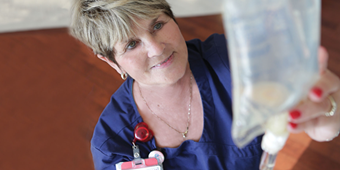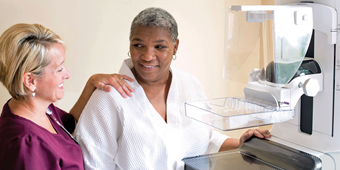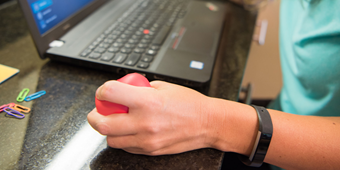How to Tame Lymphedema After Cancer

Online scheduling is available for your initial evaluation with a Premier Health Lymphedema Physical Therapist
If you’ve had any type of breast surgery, lymph nodes removed, or radiation treatment, take note of your body, comparing both sides in a mirror. Look for changes — no matter how small — in size, shape, or skin color of affected area. Talk to your doctor or cancer team if you have concerns so you can benefit from early diagnosis.
Lymphedema is as mysterious as it sounds. It’s unclear why some women are more prone than others to this build-up of fluid in the arm, breast or chest after breast cancer treatment. But one thing is certain: Once lymphedema develops, it cannot be cured, but it can be managed. Reducing your risk and catching it early is your best defense.
When lymphedema occurs after breast cancer treatment, it’s called secondary lymphedema, since it’s an acquired condition rather than one you were born with. The condition develops when the lymphatic system is damaged. That damage can result from surgery to remove lymph nodes, radiation treatment, trauma or infection.
Lymph fluid, which contains infection-fighting white blood cells, becomes trapped in the affected limb. The lymphatic system transports lymph fluid to lymph nodes that filter toxins, waste and other unwanted substances from your body. In addition to the build-up of lymph fluid, your body may experience inflammation in the affected area, resulting in scar tissue called fibrosis. This makes it even more difficult for your body to eliminate the excess fluid.
Women whose breast cancer treatment includes removal of many lymph nodes or radiation therapy are at higher risk for lymphedema. Other cancer-related surgeries also may require the removal of lymph nodes and put patients at risk for developing lymphedema. These include gynecological, head and neck, prostate or testicular, bladder and colon cancers and melanoma.
How to Recognize Lymphedema
Lymphedema may begin as a feeling of heaviness or fatigue at first. Then swelling (edema) will occur most commonly in the arm or leg. For breast cancer patients, the common areas are the arm, chest and breast.
Arm swelling soon after breast cancer surgery can mean a higher risk of lymphedema later. Some doctors measure patients’ arms before surgery and then re-measure afterward so that swelling can be detected and treated before it becomes obvious.
Early diagnosis and treatment can halt infection, minimize symptoms and reduce the risk of worsening edema. Signs and symptoms of lymphedema can include:
- Swelling in the breast, chest, shoulder, arm or hand
- Part of your body feeling full or heavy
- Skin changing texture, feeling tight or hard, or looking red
- New aching, tingling or other discomfort in the area
- Less movement or flexibility in nearby joints, such as your shoulder, hand or wrist
- Trouble fitting your arm into jacket or shirt sleeves
- Your bra not fitting as well as it used to
- Your ring, watch and/or bracelet feeling tight, and you haven’t gained weight

Can You Prevent Lymphedema?
The risk for developing lymphedema is different for every woman and also varies depending on the number of lymph nodes removed and the degree of radiation. Lymphedema may develop immediately or, more commonly, months and even years later. Once you have it, it doesn’t go away, but it can be managed – often to the point where you don’t notice it anymore.
Experts agree that following these basic steps might lower your risk of lymphedema, delay its onset or reduce its impact:
- Get regular medical check-ups. Talk to your cancer care team about how often you should be checked.
- Report any changes. After surgery, tell your cancer care team about any changes in size, color, temperature, feeling or skin condition right away.
- Try to get to and/or stay at a healthy weight. Your cancer care team can help with nutrition and exercise tips.
- Exercise. Some kinds of exercise can increase your risk of lymphedema. Consult your doctor for tips and exercises to keep lymph fluid moving and prevent swelling.
- Use compression garments. Careful fitting is needed, and you should follow your health care professional’s advice on use and care of the garment.
- Avoid infection. Take extra caution to reduce risk of injury in general, even small cuts and scrapes.
- Avoid burns and extreme temperatures. Be careful when cooking. Wear sunscreen and stay out of direct sunlight from 10 a.m. to 4 p.m. Avoid high heat from hot tubs and saunas.
- Avoid constriction. Eliminate tight jewelry, clothing and undergarments. Have blood pressure taken on the unaffected arm.
Once lymphedema develops, it cannot be cured, but it can be managed. Reducing your risk and catching it early is your best defense.
How is Lymphedema Treated?
Lymphedema should be treated right away to lower your risk of infection and complications.
Infection is a serious concern for patients with lymphedema since the fluid build-up can produce an environment for bacteria to grow. Potentially serious infections include cellulitis, a bacterial skin infection that can spread rapidly to other parts of the body, and lymphangitis, swelling of the lymph node typically caused by bacteria entering through a cut, scrape, bite or wound.
Signs and symptoms of infection generally include pain, redness, rash and/or red blotchy skin, itching of the affected area, increase of swelling, increased temperature of the skin, heavy sensation in a limb (more than usual), flu-like symptoms, and in many cases a sudden onset of high fever and chills. If these symptoms occur in the area affected by lymphedema, seek medical attention immediately.
The most common treatment for lymphedema is complete decongestive therapy (CDT), a set of techniques used in combination to reduce symptoms.
What you do at home to manage lymphedema is equally important since it’s a chronic condition with no cure. The same steps that lower your risk will also help you manage your symptoms.
Keep in mind that since tissue damage from radiation treatment can continue over many years, you should remain vigilant and never dismiss anything out of the ordinary. Prevention is always the best treatment for lymphedema.
Online scheduling is available for your initial evaluation with a Premier Health Lymphedema Physical Therapist
Source: National Lymphedema Network; American Cancer Society




